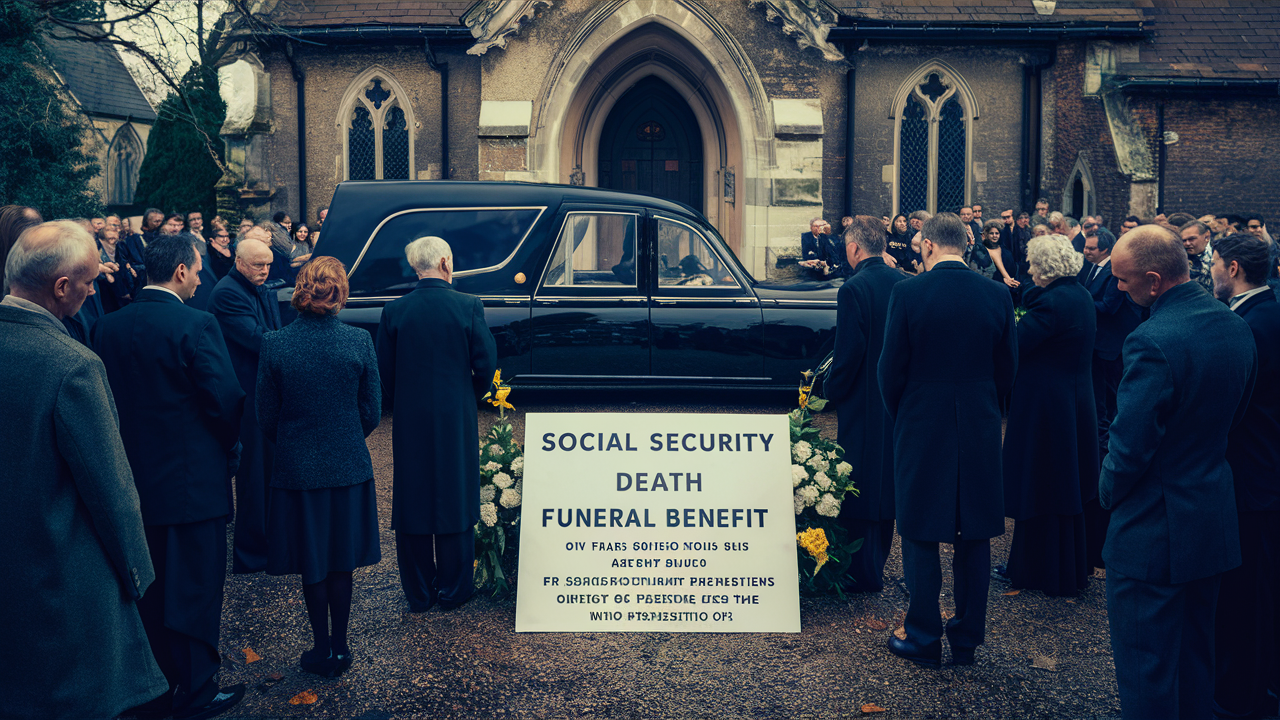What is the Social Security death funeral benefit?

The Social Security Administration (SSA) offers a one-time lump-sum death payment, often referred to as the Social Security death funeral benefit. This benefit provides a modest financial contribution to help cover immediate burial or cremation expenses for eligible individuals, offering a small measure of relief during a difficult time.
Understanding the Social Security Death Benefit
Navigating the complexities of end-of-life arrangements can be overwhelming, and understanding the financial assistance available is crucial. The Social Security Administration (SSA) provides a one-time lump-sum payment, commonly known as the Social Security death benefit, designed to offer a small but significant financial cushion to help with immediate funeral and burial expenses. This benefit is not intended to cover the entire cost of a funeral, which can be substantial, but rather to provide a foundational contribution during a period of grief and financial strain.
It's important to clarify that while many people refer to it as a "funeral benefit," the SSA officially calls it a "lump-sum death payment." The amount is fixed and does not vary based on the deceased's earnings history or the actual cost of the funeral. This distinction is vital for managing expectations and planning accordingly. Understanding the nuances of this benefit, including who is eligible, how to claim it, and what it entails, can help families make more informed decisions during a challenging time.
The primary purpose of this benefit is to ease the immediate financial burden associated with death. In 2025, the amount remains unchanged from previous years, reflecting a long-standing policy. This benefit is a component of the broader Social Security program, which aims to provide a safety net for Americans throughout their lives, including in their final moments and for their surviving family members.
What the Benefit Covers (and Doesn't Cover)
The Social Security death benefit is a fixed amount intended to assist with the costs directly associated with death and disposition. This typically includes expenses such as:
- Burial plot or cremation fees
- Casket or urn
- Funeral home services
- Basic memorial services
However, it's critical to understand that this benefit is not designed to be a comprehensive funeral insurance policy. The average cost of a funeral in the United States can range significantly, often from $7,000 to $10,000 or even more, depending on the services and choices made. The Social Security death benefit, in contrast, is a much smaller sum. For 2025, the maximum lump-sum death payment is $255. This amount has remained constant for many years, making it essential for families to plan for the majority of funeral expenses through other means.
Therefore, while the benefit is a helpful contribution, it will likely only cover a fraction of the total funeral costs. It does not cover:
- Ongoing expenses for surviving family members
- Debts of the deceased (other than those directly tied to immediate funeral arrangements)
- Estate administration costs
- Grief counseling or support services
Families should not rely solely on this benefit to fund a funeral. It serves as a small, immediate financial aid rather than a complete solution for end-of-life expenses. Understanding this limitation upfront is key to realistic financial planning for funerals.
Historical Context of the Benefit
The Social Security Act, enacted in 1935, initially included provisions for a lump-sum death payment. This was established as a way to provide immediate financial relief to surviving spouses and children upon the death of a worker. The amount of the benefit was initially tied to the deceased worker's contributions and earnings history, but it was later standardized. The current fixed amount of $255 was established in 1954 and has not been adjusted for inflation since then. This long-standing figure underscores the benefit's role as a modest, foundational contribution rather than a primary funding source for funeral costs.
Eligibility Criteria: Who Qualifies?
The Social Security death benefit is not automatically distributed to everyone upon a person's death. Specific criteria must be met by both the deceased worker and the individual applying for the benefit. Understanding these requirements is the first step in determining if this payment is available to your family.
Deceased Worker's Eligibility
To be eligible for the lump-sum death payment, the deceased individual must have earned a certain number of Social Security credits during their working life. These credits are earned by paying Social Security taxes on earnings. The number of credits required depends on the age of the worker at the time of death:
- If the worker died at age 62 or older: They must have earned at least 6 credits (equivalent to 1.5 years of work).
- If the worker died before age 62: They must have earned at least one credit for each year after 1950 (or after the year they turned 21, if later) up to the year of death. In most cases, this means they would need at least 6 credits.
In general, a worker needs 40 credits (10 years of work) to be fully insured for retirement benefits. For the death benefit, the requirement is typically lower, ensuring that even those who worked for a shorter period but contributed to Social Security can have this benefit available.
The Social Security Administration maintains records of each individual's earnings and the credits they have accumulated. You can check your own Social Security statement online through the SSA website to see your current credit status.
Applicant's Eligibility: Who Can Receive the Benefit?
Even if the deceased worker was eligible, only specific individuals can apply for and receive the lump-sum death payment. The order of priority for receiving the benefit is as follows:
- The Surviving Spouse: The surviving spouse can receive the benefit if they were living in the same household as the deceased worker at the time of death. If they were not living in the same household, the spouse can still receive the benefit if they were entitled to a Social Security benefit on the deceased's record for the month before the month of death (e.g., receiving auxiliary benefits as a spouse).
- A Surviving Child: If there is no surviving spouse living in the same household, the benefit can be paid to a child of the deceased worker who is eligible for a Social Security benefit for the month before the month of death. This typically means a child who is under age 18, or disabled before age 22.
It is important to note that the benefit is paid only once, and only to one of these eligible individuals. If a surviving spouse meets the criteria, they will receive the benefit, and a child would not be eligible unless there is no eligible spouse. The benefit is not divided among multiple eligible individuals.
Special Circumstances
In rare cases, if no eligible spouse or child can be identified, the lump-sum death payment may be used to reimburse the person who paid the funeral expenses, provided that person was legally responsible for them and met certain criteria. However, this is less common and typically requires direct application and proof of payment.
The Social Security Administration's primary focus is on direct payment to the most immediate family members who were financially or relationally connected to the deceased at the time of death.
How to Apply for the Death Benefit
Applying for the Social Security lump-sum death payment is a straightforward process, but it requires timely action. The Social Security Administration (SSA) needs to be notified of the death, and the application for the benefit should be made as soon as possible. Delays can sometimes complicate the process.
Step 1: Notify the Social Security Administration
The first and most crucial step is to report the death to the SSA. This is typically done by the funeral home, as they often handle this on behalf of the family. If you are handling arrangements yourself or the funeral home does not do this, you will need to contact the SSA directly. You can do this by:
- Calling the SSA: The toll-free number is 1-800-772-1213.
- Visiting a local Social Security office: You can find your nearest office on the SSA website.
When you contact the SSA, you will need to provide information about the deceased, including their Social Security number, date of birth, and date of death. You will also need to provide your own contact information.
Step 2: Gather Necessary Documentation
To process the claim, the SSA will require certain documents. It is best to have these ready when you contact them or visit an office. The primary documents needed are:
- Proof of Death: This is usually a death certificate. A certified copy is often required.
- Your Proof of Identity: Such as a driver's license or passport.
- Proof of Relationship: If you are applying as a surviving spouse, you may need a marriage certificate. If applying as a child, proof of parentage might be required.
- The Deceased's Social Security Number: This is essential for them to locate the record.
The SSA representative will guide you on the exact documents needed based on your specific situation.
Step 3: Complete the Application
The application for the lump-sum death payment is usually completed during your conversation with the SSA representative, either over the phone or in person. They will ask a series of questions to gather the necessary information and determine eligibility. If you are applying in person, you will likely fill out a specific form, such as the SSA-8 form (Application for Lump-Sum Death Payment).
Key information you will be asked to provide includes:
- The deceased's full name and Social Security number.
- The date and place of death.
- Your relationship to the deceased.
- Your contact information.
- Information about the funeral home or funeral director, if applicable.
- Details about any other individuals who might be eligible for the benefit.
Step 4: Receiving the Payment
Once your application is approved, the lump-sum death payment of $255 will be issued. This payment is typically sent via check to the eligible applicant. The processing time can vary, but it generally takes a few weeks to a couple of months. If the funeral home has paid for the burial or cremation expenses, and they have the necessary documentation and your authorization, they may be able to receive the payment directly to reimburse them.
Important Note on Timing: You must apply for the lump-sum death payment within two years of the date of death. If you do not apply within this timeframe, you will forfeit the benefit.
For those who have recently lost a loved one, the process can feel daunting. Reaching out to the SSA or a knowledgeable funeral director can provide the necessary guidance and support to navigate this application process effectively.
Benefit Amount and Payment Details
The Social Security lump-sum death payment is a fixed amount, and understanding its value and how it is disbursed is crucial for financial planning and managing expectations during a difficult time.
The Fixed Amount: $255
As previously mentioned, the lump-sum death payment from Social Security is a set amount: $255. This figure has remained unchanged since 1954. It is not influenced by the deceased's earnings history, the number of years they worked, or the total amount of Social Security taxes they paid. This fixed amount is a key characteristic of the benefit and highlights its role as a small, immediate financial aid rather than a comprehensive funeral fund.
For comparison, consider the average funeral costs in 2025, which are estimated to be:
| Service Type | Estimated Cost (2025) |
|---|---|
| Traditional Funeral with Burial | $8,000 - $12,000+ |
| Funeral with Cremation | $6,000 - $9,000+ |
| Direct Cremation (no service) | $2,000 - $4,000+ |
Note: These are estimates and can vary significantly by location and specific choices.
As the table illustrates, the $255 Social Security benefit covers only a small percentage of the overall funeral expenses. This underscores the need for families to explore other financial resources for funeral planning.
How the Payment is Disbursed
The $255 lump-sum death payment is issued only once. It is paid to the first eligible person who applies:
- To the Surviving Spouse: If the surviving spouse was living in the same household as the deceased worker at the time of death, the payment is sent to them.
- To a Surviving Child: If there is no spouse living in the same household, the payment is sent to a child who is eligible for Social Security benefits on the deceased's record for the month before the death.
If the funeral home has paid for the burial or cremation expenses, and they have the necessary documentation and the applicant's consent, the payment can be sent directly to the funeral home to reimburse them. This is a common arrangement, as funeral homes often handle the initial costs and paperwork.
The payment is typically issued as a check from the U.S. Treasury. It is not subject to federal income tax. However, it is considered income for state income tax purposes in some states, though most states do not tax it.
What Happens If No Eligible Applicant is Found?
In the rare instance that no eligible spouse or child can be identified or located within the two-year application period, the lump-sum death payment may be used to reimburse the person who paid the funeral expenses, provided they were legally responsible for them and meet specific SSA criteria. This is a less common scenario and requires the applicant to provide detailed proof of payment and responsibility.
The SSA's priority is always to ensure the benefit reaches the closest eligible family members first. This ensures the payment is used for its intended purpose of providing immediate financial relief to those most directly impacted by the loss.
Processing Time
Once an application is submitted and approved, the processing time for the lump-sum death payment can vary. Generally, it takes anywhere from a few weeks to a couple of months for the check to be issued and mailed. The SSA processes these claims as efficiently as possible, but the exact timing depends on the volume of claims and the completeness of the information provided.
It is advisable to follow up with the SSA if you have not received the payment within two months of your application, especially if you have urgent funeral expenses to cover.
Common Misconceptions About the Death Benefit
The Social Security lump-sum death payment is often misunderstood, leading to confusion and unmet expectations among families. Addressing these common misconceptions is vital for accurate planning and understanding.
Misconception 1: It's a Large Sum of Money
Reality: One of the most prevalent misconceptions is that the Social Security death benefit is a substantial amount that will significantly cover funeral costs. As established, the benefit is a fixed $255. While it's a helpful contribution, it is far from sufficient to cover the average cost of a funeral, which can range from $6,000 to over $10,000 in 2025. Families should never rely on this benefit as their sole source of funeral funding.
Misconception 2: Everyone Gets It
Reality: The benefit is not automatic for every deceased individual. The deceased must have earned a minimum number of Social Security credits to be eligible. Furthermore, only specific individuals—primarily a surviving spouse living in the same household or an eligible child—can claim the benefit. It is not a universal payout.
Misconception 3: It's Paid to All Surviving Family Members
Reality: The lump-sum death payment is a single, one-time payment. It is paid to only one eligible individual, typically the surviving spouse. If there is no eligible spouse, it may be paid to an eligible child. It is not divided among multiple family members, nor is it paid to siblings, parents, or other relatives unless they meet the specific criteria of being an eligible spouse or child.
Misconception 4: It's Paid Automatically When Someone Dies
Reality: The SSA does not automatically send the death benefit. A surviving family member must actively report the death to the SSA and apply for the benefit. While funeral homes often assist with this, it is the responsibility of the family to ensure the application is submitted. There is also a two-year deadline for applying.
Misconception 5: It's Taxable Income
Reality: The $255 lump-sum death payment is generally not subject to federal income tax. While some states might consider it taxable income for state purposes, this is uncommon. It is important to check with your state's tax regulations if you have concerns.
Misconception 6: It Covers All Funeral Expenses
Reality: This benefit is intended to provide a small, immediate financial contribution towards funeral costs, not to cover them entirely. It's a modest sum designed to help with initial expenses, such as a portion of burial fees or cremation costs. Families must plan for the majority of funeral expenses through savings, life insurance, or other financial resources.
Misconception 7: It's Available for Any Death, Regardless of Work History
Reality: The deceased must have worked and paid Social Security taxes for a sufficient period to earn the required credits. Individuals who never worked or worked very little may not meet the eligibility criteria for the deceased worker. This benefit is tied to their record of contributions to the Social Security system.
By understanding these common misconceptions, individuals can approach the Social Security death benefit with realistic expectations and ensure they are properly prepared for funeral planning and the application process.
Alternative Funeral Funding Options
Given that the Social Security death benefit is a modest $255, families often need to explore additional avenues to cover the full cost of funeral arrangements. Fortunately, several alternative options are available to help manage these expenses in 2025.
Life Insurance Policies
Life insurance is a primary tool for funeral planning. There are two main types:
- Term Life Insurance: Provides coverage for a specific period. It is generally more affordable and can offer substantial death benefits to cover funeral costs and other financial obligations.
- Whole Life Insurance: Offers lifelong coverage and builds cash value over time. While typically more expensive than term life, it provides a guaranteed payout regardless of when the insured dies.
Many life insurance policies allow beneficiaries to receive funds quickly after the death, often within days, which can be crucial for immediate funeral expenses. Some policies even offer accelerated death benefits, allowing a portion of the payout to be accessed while the insured is still alive if diagnosed with a terminal illness.
Burial Insurance (Final Expense Insurance)
This is a type of whole life insurance policy designed specifically to cover funeral and burial costs. Policies are typically for smaller amounts, ranging from $5,000 to $10,000, making them more accessible and affordable for individuals with limited incomes or health concerns. Approval is often guaranteed, even for those with pre-existing medical conditions, though premiums might be higher.
Prepaid Funeral Plans
These plans allow individuals to make arrangements and pay for their funeral services in advance. You can work with a funeral home to select specific services, merchandise (like caskets or urns), and even choose burial or cremation options. The costs are typically "locked in" at the time of purchase, protecting against future price increases. Funds are usually placed in a trust or insurance policy managed by the funeral home or a third party.
Benefits of Prepaid Plans:
- Locks in current prices
- Reduces the financial burden on loved ones
- Allows for detailed personal preferences to be documented
Considerations: Ensure the funeral home is reputable and understand the terms regarding portability if you move or if the funeral home goes out of business.
Savings and Investments
For those who have planned ahead, existing savings accounts, certificates of deposit (CDs), or investment portfolios can be used to cover funeral expenses. This is often the most straightforward method if sufficient funds are available. The proceeds from these assets can be accessed by the executor of the estate or beneficiaries after death.
Veterans Benefits
Eligible veterans may be entitled to certain burial benefits from the Department of Veterans Affairs (VA). These can include:
- A burial allowance to help defray costs.
- A plot allowance if the veteran is not buried in a national cemetery.
- Burial in a national cemetery, which often includes a gravesite, opening and closing of the grave, a concrete grave liner, and a headstone or marker, all at no cost to the family.
Eligibility for these benefits depends on factors such as the veteran's discharge status and whether the death was service-related.
Community and Religious Organizations
Some religious organizations, fraternal societies, or community groups may offer financial assistance or support for funeral arrangements for their members. These resources can vary widely but are worth exploring, especially if the deceased was an active member of such a group.
Crowdfunding and Community Support
In recent years, online crowdfunding platforms (like GoFundMe) have become a popular way for families to raise funds for funeral expenses. This approach leverages the support of friends, family, and the wider community to help offset the financial burden. While not a guaranteed source of funds, it can provide significant assistance.
By understanding and utilizing these alternative funding options, families can ensure that their loved ones receive a dignified farewell without facing overwhelming financial stress, complementing the modest Social Security death benefit.
Planning Ahead for Funeral Costs
Proactive funeral planning is an act of kindness and responsibility towards loved ones. While the Social Security death benefit offers a small contribution, the majority of funeral costs must be covered through other means. Planning ahead ensures your wishes are honored and alleviates financial and emotional burdens on your family during their time of grief.
Why Plan Ahead?
Funeral costs can be a significant financial strain. The average funeral in 2025 can cost thousands of dollars. Without prior planning, surviving family members may:
- Be forced to make hasty decisions under emotional duress.
- Incur debt to cover expenses.
- Choose less desirable or more expensive options due to immediate financial constraints.
- Experience added stress during a period of mourning.
Planning ahead allows you to make informed choices about your own funeral, memorial services, and disposition, reflecting your personal preferences and values. It also provides financial certainty for your family.
Key Elements of Funeral Planning
When planning ahead, consider the following aspects:
1. Document Your Wishes
Clearly outline your preferences for:
- Burial or Cremation: Specify your choice and any particular rituals or ceremonies associated with it.
- Type of Service: Traditional funeral, memorial service, celebration of life, or direct disposition.
- Location of Services: Funeral home, place of worship, family home, or other venue.
- Specific Readings, Music, or Participants: If you have particular songs, poems, or individuals you wish to involve.
- Obituary Details: Information you want included.
Store these wishes in a safe, accessible place and inform a trusted executor or family member of their location.
2. Determine Funding Methods
As discussed in the previous section, consider how these costs will be met:
- Prepaid Funeral Plans: Pay for services in advance, locking in current prices.
- Life Insurance: Purchase a policy specifically for funeral expenses or ensure an existing policy has a sufficient death benefit.
- Burial/Final Expense Insurance: Smaller, specialized policies for end-of-life costs.
- Savings/Investments: Designate specific funds or accounts for funeral expenses.
- Trust Funds: Establish a trust to hold and disburse funds for funeral arrangements.
It is crucial to select a funding method that aligns with your financial situation and provides adequate coverage.
3. Discuss with Your Family and Executor
Open communication is vital. Share your plans with your family and the person you designate as your executor. This ensures they are aware of your wishes and the financial arrangements made, preventing misunderstandings and disputes.
4. Organize Important Documents
Keep all relevant documents organized and accessible. This includes:
- Your will
- Life insurance policies
- Prepaid funeral contracts
- Deeds and titles
- Bank account information
- Social Security card (or number)
- Birth certificate
Provide your executor with a list of these documents and their locations.
The Role of the Executor
Your executor is responsible for carrying out the terms of your will and managing your estate, which includes making funeral arrangements and settling debts. Ensuring they have clear instructions and access to necessary funds is paramount.
Utilizing the Social Security Benefit in Planning
While the $255 Social Security death benefit is a small part of the overall picture, it can be factored into your financial planning. It can be considered a contribution towards initial expenses, such as a deposit for a funeral home or cremation service, or it can be used to supplement other funds.
For example, if you have a prepaid funeral plan that covers most costs, the $255 could be used by the family for other immediate needs or as a small memorial contribution. If you are relying on life insurance, the Social Security benefit can reduce the amount you need to claim from the policy, leaving more for other beneficiaries.
Planning ahead for funeral costs is a responsible and loving act. By understanding all available resources, including the Social Security death benefit and alternative funding options, you can ensure your final wishes are met with dignity and without undue burden on your loved ones.
Conclusion
The Social Security death funeral benefit, officially known as the lump-sum death payment, provides a fixed amount of $255 to eligible surviving family members. While this benefit offers a small financial contribution to help with immediate burial or cremation expenses, it is crucial to understand that it is not intended to cover the full cost of a funeral, which can be substantially higher. Eligibility for the deceased worker requires a minimum number of Social Security credits, and the benefit is payable only to a surviving spouse living in the same household or an eligible child.
Applying for this benefit involves notifying the Social Security Administration promptly and providing necessary documentation, such as a death certificate and proof of relationship. The application must be made within two years of the date of death. It is vital to dispel common misconceptions, such as the benefit being a large sum or automatically paid to all family members. Understanding these nuances ensures realistic expectations and proper planning.
Given the limited amount of the Social Security benefit, families should explore alternative funeral funding options. These include life insurance policies, burial insurance, prepaid funeral plans, savings, veterans benefits, and community support. Proactive funeral planning is a thoughtful way to honor your wishes, reduce the financial burden on your loved ones, and ensure a dignified farewell. By combining the modest Social Security benefit with these other resources and thorough planning, families can navigate end-of-life arrangements with greater confidence and peace of mind.





